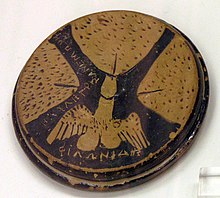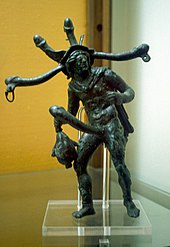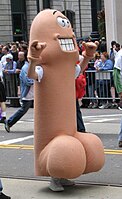Phallus
This article needs additional citations for verification. (September 2023) |

A phallus (pl.: phalli or phalluses) is a penis (especially when erect),[1] an object that resembles a penis, or a mimetic image of an erect penis. In art history, a figure with an erect penis is described as ithyphallic.
Any object that symbolically—or, more precisely, iconically—resembles a penis may also be referred to as a phallus; however, such objects are more often referred to as being phallic (as in "phallic symbol"). Such symbols often represent fertility and cultural implications that are associated with the male sexual organ, as well as the male orgasm.
Etymology

The term is a loanword from Latin phallus, itself borrowed from Greek φαλλός (phallos), which is ultimately a derivation from the Proto-Indo-European root *bʰel- "to inflate, swell". Compare with Old Norse (and modern Icelandic) boli, "bull", Old English bulluc, "bullock", Greek φαλλή, "whale".[2]
Archaeology
The Hohle phallus, a 28,000-year-old siltstone phallus discovered in the Hohle Fels cave and reassembled in 2005, is among the oldest phallic representations known.[3]
Religion
Ancient Egypt

The phallus played a role in the cult of
The phallus was a symbol of fertility, and the god Min was often depicted as ithyphallic, that is, with an erect penis.

Ancient Greece and Rome

In traditional
Priapus is a Greek god of fertility whose symbol was an exaggerated phallus. The son of Aphrodite and Dionysus, according to Homer and most accounts, he is the protector of livestock, fruit plants, gardens, and male genitalia. His name is the origin of the medical term priapism.
The city of Tyrnavos in Greece holds an annual Phallus festival, a traditional event celebrating the phallus on the first days of Lent.[4]
The phallus was ubiquitous in
Ancient India

Shiva, one of the most widely worshiped male deities in Hinduism pantheon, is worshiped much more commonly in the form of the lingam. Evidence of the lingam in India dates back to prehistoric times. Although Lingam is not a mere phallic iconography, nor do the textual sources signify it as so, stone Lingams with several varieties are found to this date in many of the old temples and in museums in India and abroad, which are often more clearly phallic than later stylized lingams. The famous "man-size" Gudimallam Lingam in Andhra Pradesh is about 1.5 metres (5 ft) in height, carved in polished black granite, and clearly represents an erect phallus, with a figure of the deity in relief superimposed down the shaft.[8]
Many of the earliest depictions of Shiva as a figure in human form are ithyphallic, for example, in coins of the Kushan Empire. Some figures up to about the 11th century AD have erect phalluses, although they have become increasingly rare.
Indonesia
According to the Indonesian chronicles of the Babad Tanah Jawi, Prince Puger gained the kingly power from God by ingesting semen from the phallus of the already-dead Sultan Amangkurat II of Mataram.[9][10]
Bhutan
The phallus is commonly depicted in its paintings. Wooden phalluses, with white ribbons hanging from the tip, are often hung above the doorways of houses to deter evil spirits.

- The Norse god Freyr is a phallic deity, representing male fertility and love.
- The short story horse penis.
- Some Tängelgårda stones, were phallic shaped.
Iran
Japan
The Mara Kannon Shrine (麻羅観音) in
, though historically phallus adoration was more widespread.Balkans
Kuker is a divinity personifying fecundity, sometimes in
Switzerland
In Switzerland, the heraldic bears in a coat of arms had to be painted with bright red penises, otherwise, they would have been mocked as being she-bears. In 1579, a calendar printed in St. Gallen omitted the genitals from the heraldic bear of Appenzell, nearly leading to war between the two cantons.[13][14][15]
The Americas
Figures of
Alternative sects
Psychoanalysis

The symbolic version of the phallus, a phallic symbol, is meant to represent male generative powers. According to Sigmund Freud's theory of psychoanalysis, while males possess a penis, no one can possess the symbolic phallus.
Jacques Lacan's Ecrits: A Selection includes an essay titled The Signification of the Phallus in which sexual differentiation is represented in terms of the difference between "being" and "having" the phallus, which for Lacan is the transcendent signifier of desire. Men are positioned as men insofar as they wish to have the phallus. Women, on the other hand, wish to be the phallus. This difference between having and being explains some tragicomic aspects of sexual life. Once a woman becomes, in the realm of the signifier, the phallus the man wants, he ceases to want it because one cannot desire what one has, and the man may be drawn to other women. Similarly, though, for the woman, the gift of the phallus deprives the man of what he has and thereby diminishes her desire.
It should be remembered that the phallōs was a symbol of the real penis in its erect imaginary form.[18]
— Michael Lewis
Norbert Wiley states that Lacan's phallus is akin to Durkheim's
In Gender Trouble, Judith Butler explores Freud's and Lacan's discussions of the symbolic phallus by pointing out the connection between the phallus and the penis. They write, "The law requires conformity to its own notion of 'nature'. It gains its legitimacy through the binary and asymmetrical naturalization of bodies in which the phallus, though clearly not identical to the penis, deploys the penis as its naturalized instrument and sign". In Bodies that Matter, they further explore the possibilities for the phallus in their discussion of The Lesbian Phallus. If, as they note, Freud enumerates a set of analogies and substitutions that rhetorically affirm the fundamental transferability of the phallus from the penis elsewhere, then any number of other things might come to stand in for the phallus.
Modern use of the phallus
The phallus is often used for advertising
The phallus had a new set of art interpretations in the 20th century with the rise of
-
A woman riding a phallicEXXXOTICANew York 2009
-
Penis costume at a 2005 parade in San Francisco
-
Monument to the Carnation Revolution, Lisbon, Portugal
See also
- Dog's bollocks (typography)
- Hōnen Matsuri
- Kanamara Matsuri
- Mars symbol
- Maypole
- Phallic architecture
- Most Phallic Building contest
- Phallic narcissism
- Phallus paintings in Bhutan
References
Citations
- ^ "Definition of phallus in English" Oxford Dictionaries. Retrieved 16 August 2013.
- ^ etymonline.com
- ^ Amos, Jonathan (2005-07-25). "Ancient phallus unearthed in cave". BBC News. Retrieved 2006-07-08.
- ^ "The Annual Phallus Festival in Greece", Der Spiegel, English edition, Retrieved on the 15-12-08
- T.P. Wiseman, Remus: A Roman Myth (Cambridge University Press, 1995), p. 61 online.
- ^ Joseph Rykwert, The Idea of a Town: The Anthropology of Urban Form in Rome, Italy, and the Ancient World (MIT Press, 1988), pp. 101 and 159 online.
- ^ David J. Mattingly, Imperialism, Power, and Identity: Experiencing the Roman Empire (Princeton University Press, 2011), p. 106.
- ^ Rao, T. A. Gopinatha, Elements Of Hindu Iconography, Vol II Part 1, 1916, Law Printing House, Madras (Chennai), Internet Archive (fully online), p. 65 on; thenewsminute.com
- ISBN 9786028397438.
- ISBN 9789004084223.
- ^ Danjiri Matsuri Festival
- ISBN 973-29-0030-X.
- ISBN 9780070463080.
- ^ Strehler, Hermann (1965). "Das Churer Missale von 1589". Gutenberg-Jahrbuch. 40: 186.
- ^ Grzimek, Bernhard (1972). Grzimek's Animal life encyclopedia. Vol. 12. New York: Van Nostrand Reinhold Co. p. 119.
- ^ Amrhein, Laura Marie (2001). An Iconographic and Historic Analysis of Terminal Classic Maya Phallic Imagery. Unpublished PhD dissertation, Richmond: Virginia Commonwealth University.
- ISBN 0-8103-7714-4p. 952.
- JSTOR 10.3366/j.ctt1r2cj3.7.
- ISBN 0-226-89816-4.
As I read Lacan, the first signifier (his ambiguous 'phallus') or entry into the universe of public meaning is the same as Durkheim's 'mana' (see Levi-Strauss, 1950/1987, pp. 55-56 for the idea of mana as the "floating signifer;" and Mehlman, 1972, for an attempt, not completely successful, to integrate the semiotic meanings of Levi-Strauss's mana and Lacan's phallus).
- ^ Hurwitt, Robert (2002-11-01). "Puppetry of the Penis". San Francisco Chronicle. Retrieved 2008-12-01.
- ^ Philamuseum.org
- ^ Mary Roach. Bonk: The Curious Coupling of Science and Sex. W. W. Norton and Co, New York (2008). page 66f, page 73
Bibliography
- Vigeland Monolith – Oslo, Norway Polytechnique.fr Archived 2017-09-07 at the Wayback Machine
- Dulaure, Jacques-Antoine (1974). Les Divinités génératrices. Vervier, Belgium: Marabout. Without ISBN.
- Honour, Hugh (1999). The Visual Arts: A History. New York: H.N. Abrams. ISBN 0-8109-3935-5.
- Keuls, Eva C. (1985). The Reign of the Phallus. New York: Harper & Row. ISBN 0-520-07929-9.
- Kernbach, Victor (1989). Dicţionar de Mitologie Generală. Bucureşti: Editura Ştiinţifică şi Enciclopedică. ISBN 973-29-0030-X.
- Leick, Gwendolyn (1994). Sex and Eroticism in Mesopotamian Literature. New York: Routledge. ISBN 0-415-06534-8.
- Lyons, Andrew P.; Harriet D. Lyons (2004). Irregular Connections: A History of Anthropology and Sexuality. ISBN 0-8032-8036-X.
- Jesse Bering (April 27, 2009). "Secrets of the Phallus: Why Is the Penis Shaped Like That?". Scientific American. Archived from the original on 2011-02-24.
External links
 Media related to Phallus at Wikimedia Commons
Media related to Phallus at Wikimedia Commons- . Encyclopædia Britannica. Vol. 21 (11th ed.). 1911. p. 345.



